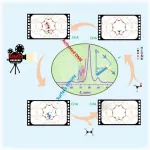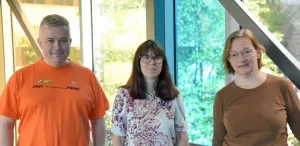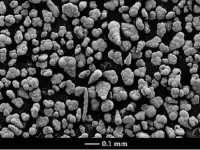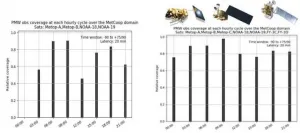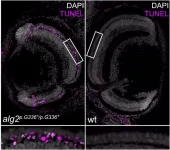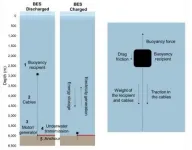(Press-News.org) CHAPEL HILL, NC--Researchers at the University of North Carolina at Chapel Hill and the UNC Lineberger Comprehensive Cancer Center have uncovered a new mechanism that activates specific genes, leading to the development of cancers.
They showed that a mutation that fuses two unrelated genes can promote a process similar to that observed when oil and water are mixed but do not blend together. The process, called liquid-liquid phase separation, occurs inside a cell's nucleus and enables the formation of compartments with various physical properties that can promote cancers such as acute leukemias. Their findings will be published online June 23, 2021, in Nature.
"Phase separation and its role in cancer has been a missing puzzle piece in understanding this disease," said UNC Lineberger's Greg Wang, PhD, associate professor of Biochemistry and Biophysics and Pharmacology at the UNC School of Medicine and co-lead author of this article. "This finding is among the first to link phase separation to cancer formation."
The discovery brings new insights to a complex, multistep process that bridges biology and physics. To help unravel this process, the investigators performed laboratory experiments in cancer cells that carried a common gene fusion called NUP98-HOXA9. This aberrant fusion is found solely in blood cells of patients that develop leukemia.
"Because similar gene fusions have been observed in other malignancies, the mechanism we elucidated could explain other types of cancer as well," said UNC Lineberger's Douglas H. Phanstiel, PhD, assistant professor of Cell Biology and Physiology at the UNC School of Medicine and co-lead author of this article. "We believe that our research could open up new and innovative avenues to attack cancer cells."
Within the proteins produced by NUP98-HOXA9 are unstructured stretches, known as intrinsically disordered regions, or IDRs. The role of IDRs has been a mystery, but the researchers showed that IDRs promote liquid-liquid phase separation of NUP98-HOXA9 proteins when they reach critical concentrations in the nucleus, causing NUP98-HOXA9 to become phased, or compartmentalized.
"The way that liquid-liquid phase separation alters the behavior of NUP98-HOXA9 proteins is that it makes them bind to target genes much more strongly," said Jeong Hyun Ahn, PhD, a postdoctoral fellow at UNC and first author of this article. "DNA binding of NUP98-HOXA9 proteins, when they are phase-separated, generates a unique pattern called a 'super-enhancer.' Stronger, super enhancer-like binding by NUP98-HOXA9 proteins to DNA leads to more potent activity of this factor, which underlies the formation of aggressive blood cancers."
"Theoretically, a drug that specifically disrupts or dissolves the phase-separated liquid droplets formed by NUP98-HOXA9 could be a therapeutic agent," Wang said. "We hope to look into possible therapeutic agents that target phase separation as we know that this process can also impact neurodegenerative diseases such as Alzheimer's where plaques that build up in the brain may be due, in part, to liquid-liquid phase separation."
The researchers also discovered that phase separation can influence the three-dimensional structure of the genome by creating chromatin loops, which organize the genome and help control which regions are active and which are not. But alterations in this structure can cause human disease when they are aberrantly formed.
"Our discovery is the first clear evidence of chromatin loops formed by phase separation," Phanstiel said. "This new class of loops appears to be driving cancer development by connecting regulatory regions of chromatin to cancer genes, thereby increasing cancer gene expression and lethality."
Taken together, the complex interplay of biology, physics and genetics inside a cell is now better understood due to this latest research finding. Having performed most of their experiments in the lab, the scientists hope to be able to study certain aspects of the process in living organisms and other diseases in the near future.
INFORMATION:
Authors and disclosures
In addition to Wang, Phanstiel and Ahn, the paper's other authors are Eric S. Davis, Timothy A. Daugird, Shuai Zhao, Ivana Yoseli Quiroga, Hidetaka Uryu, Jie Li, Yi-Hsuan Tsai, Daniel P. Keeley, Ling Cai and Wesley R. Legant, UNC; Aaron J. Storey, Samuel G. Mackintosh, Ricky D. Edmondson, Stephanie D. Byrum, and Alan J. Tackett at the University of Arkansas for Medical Sciences, Little Rock; and Deyou Zheng at the Albert Einstein College of Medicine, Bronx, NY.
The authors declare no competing interests.
A joint research team led by Prof. LIU Zhongmin, Prof. WEI Yingxu, and Prof. XU Shutao from the Dalian Institute of Chemical Physics (DICP) of the Chinese Academy of Sciences (CAS) revealed the mechanism underlying the formation of the first carbon-carbon (C-C) bond formation during the methanol-to-olefins (MTO) process.
This study was published in Chem on June 23.
Prof. ZHENG Anmin's group from Innovation Academy for Precision Measurement Science and Technology of CAS was also involved in the study.
The first C-C bond in the MTO process is formed at the initial stage of the reaction. There is no direct method to elucidate the bond formation /reaction mechanism due to the difficulty in capturing intermediate species.
"We investigated the ...
A paper published in the prestigious journal Nature Medicine on long-COVID, describes persistent symptoms six months after acute COVID-19, even in young home isolated people.
The study from the Bergen COVID-19 Research Group followed infected patients during the first pandemic wave in Bergen Norway.
"The main novel finding is that more than fifty per cent of young adults up to 30 years old, isolated at home, still have persistent symptoms six months after mild to moderate disease", the leader of the group, Professor Nina Langeland explains.
The most common symptoms were loss of smell and/or taste, fatigue, ...
Pioneering research has shown marine ecosystems can start working again, providing important functions for humans, after being wiped out much sooner than their return to peak biodiversity.
The study, led by the University of Bristol and published today in Proceedings of the Royal Society B, paves the way for greater understanding of the impact of climate change on all life forms.
The international research team found plankton were able to recover and resume their core function of regulating carbon dioxide levels in the atmosphere more than twice as fast as they regained full levels of biodiversity.
Senior author Daniela Schmidt, Professor ...
An accurate, non-invasive, and low-cost method of testing for COVID-19 using samples taken from the screens of mobile phones has been developed by a team led by UCL researchers at Diagnosis Biotech.
The study, published in eLife and led by Dr Rodrigo Young (UCL Institute of Ophthalmology), analysed swabs from smartphone screens rather than directly from people, and found that people who tested positive by the regular nasal swabbing PCRs were also positive when samples were taken from phone screens.
The new method - known as Phone Screen Testing (PoST) - detected the COVID-19 virus on the phones of 81 to 100% of contagious people with a high viral load, suggesting it is as accurate as antigen lateral flow tests.
Globally active screening for COVID-19 is still a priority ...
Modern weather forecasts rely heavily on data retrieved from numerical weather prediction models. These models continue to improve and have advanced considerably throughout more than half a century. However, forecast reliability depends on the quality and accuracy of initialization data, or a sample of the current global atmosphere when the model run is started. This process of bringing surface observations, radiosonde data, and satellite imagery together to create a picture of the initial atmospheric state is called data assimilation. Satellite upgrades have significantly improved this process, providing more data than ever before. Several recent studies show ...
A rare genetic defect that affects the so-called ALG2 gene can cause serious metabolic diseases in humans. It does so through the defective formation of proteins and sugar molecules. Until now, its rareness and complexity made it difficult to study this congenital glycosylation disorder. A research team led by Prof. Dr Joachim Wittbrodt and Dr Thomas Thumberger from the Centre for Organismal Studies (COS) of Heidelberg University has finally succeeded in introducing the underlying mutation in the ALG2 gene in a fish model, thus allowing the causes of these complex diseases to be studied at the molecular level.
Human cells are kept alive by the activity of millions of proteins. As they mature, these proteins ...
What do pipes and anchors have to do with storing energy? More than you might think! A new IIASA-led study explored the potential of a lesser known, but promising sustainable energy storage system called Buoyancy Energy Storage.
There is general consensus that renewable energy sources will play an important role in ensuring a healthier and more sustainable future for the planet and its people, and many countries are indeed already seeing such technologies displacing "dirty" fossil fuels in the power sector in an effort to lower emissions. The biggest problem with renewable energy sources, however, is that power supply is intermittent, meaning that the energy output at any given time does not necessarily meet the demand at that time. ...
Our homes and offices are only as solid as the ground beneath them. When that solid ground turns to liquid -- as sometimes happens during earthquakes -- it can topple buildings and bridges. This phenomenon is known as liquefaction, and it was a major feature of the 2011 earthquake in Christchurch, New Zealand, a magnitude 6.3 quake that killed 185 people and destroyed thousands of homes.
An upside of the Christchurch quake was that it was one of the most well-documented in history. Because New Zealand is seismically active, the city was instrumented ...
Several eye clinics around Sweden are seeing a rise in eye damage related to the racket sport padel. In an article in the Journal of the Swedish Medical Association (Läkartidningen), eye researchers affiliated with the University of Gothenburg state that padel is a potential high-risk sport for eye injuries, and that wearing protective goggles is a good idea.
Ball sports are often associated with an increased risk of eye injuries, and the risk seems to be even greater with padel, a sport that is now highly popular in Sweden (and should not be confused with the North American "paddle tennis").
"The ...
ITHACA, N.Y. - Coming soon to a lab tabletop near you: a method of magneto-thermal imaging that offers nanoscale and picosecond resolution previously available only in synchrotron facilities.
This innovation in spatial and temporal resolution will give researchers extraordinary views into the magnetic properties of a range of materials, from metals to insulators, all from the comfort of their labs, potentially boosting the development of magnetic storage devices.
"Magnetic X-ray microscopy is a relatively rare bird," said Greg Fuchs, associate professor of applied and engineering physics, who led the project. "The magnetic ...

